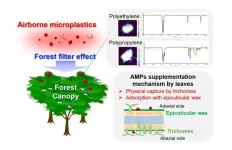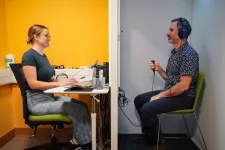(Press-News.org) Rabbits are popular family pets, with around 1.5 million* in the UK and it is important that owners can recognise when their animal is in pain, and know when to seek help to protect their rabbit’s welfare. New research by the University of Bristol Veterinary School has found the majority of rabbit owners could list signs of pain and could mostly identify pain-free rabbits and those in severe pain, but many lacked knowledge of the subtler sign of pain.
The study, published in BMC Veterinary Research today [27 March], provides the first insight into how rabbit owners identify pain and their general ability to apply this knowledge to detect pain accurately.
Rabbits are prey species and have evolved to hide signs of illness and pain. Recent research has developed pain scales for use by veterinary professionals - including the Bristol Rabbit Pain Scale (BRPS) - but to date research hasn’t investigated rabbit owners’ ability to recognise pain in their animals.
The study explored how owners identify pain in their pet rabbits and their ability to correctly spot different levels of pain, and to find out areas in which owners would benefit from education.
Owners were recruited via a variety of routes including Facebook and completed a two-part online survey. Part one collected data on demographics, owners’ knowledge of pain signs and beliefs about pain in rabbits. Part two asked respondents to pain score eight videos, recorded during routine veterinary treatment, of rabbits in different levels of pain for comparison to pain scores made by three experts.
The researchers used a simplified version of the BRPS which involved a single 0 to 3 scale. The research team explored the number of pain signs each respondent could list, the total score given to the videos, and their difference from the experts’ scores.
A total of 500 people completed part one of the survey and 345 completed part two. Respondents were mostly able to identify five signs of pain (such as anorexia, and changes in posture and movement), but many were less aware that decreases in grooming behaviour and changes to eye and ear position can also be signs of pain. Women, people who worked with rabbits, and those with experience of their rabbit having an operation recognised pain more accurately.
Overall, 98.6 per cent of respondents thought correctly that rabbits felt pain as much or more than dogs and cats. In part two, respondents more frequently agreed with the experts when identifying rabbits in no pain (88.8 per cent) and severe pain (65.2 per cent), but there was lower agreement when recognising mild (28.4 per cent) and moderate pain (43.2 per cent). Respondents overall rated pain lower than experts with an average total pain score of 11.9 compared to 18 given by the expert.
Dr Nicola Rooney, Senior Lecturer in Wildlife and Conservation at Bristol Veterinary School and corresponding author, said: “Most rabbit owners were able to list numerous pain signs and were generally able to recognise pain-free rabbits and those in severe pain. Owners’ ability to differentiate between mild and moderate pain is more limited and they could benefit from training in the subtler signs of pain. Veterinary professionals should also be aware of areas where owners’ knowledge can be improved.”
Charlotte Forder, lead author, who conducted the study for her final BSc Veterinary Nursing and Bioveterinary Science research dissertation, added: “Our study highlighted a gap in the communication between owners and veterinary professionals. Speaking to, and advising, owners when animals are having procedures is important, so the animal has the best outcome. It is also a great opportunity for the veterinary community to educate owners about signs of pain in rabbits.”
END
UK rabbit owners can recognize pain in their pets, study finds
2024-03-27
ELSE PRESS RELEASES FROM THIS DATE:
World's first demonstration that forests trap airborne microplastics
2024-03-27
A research group led by Japan Women’s University finds that airborne microplastics adsorb to the epicuticular wax on the surface of forest canopy leaves, and that forests may act as terrestrial sinks for airborne microplastics
Tokyo, Japan – Think of microplastics, and you might think of the ones accumulating in the world’s oceans. However, they are also filling the sky and the air we breathe. Now, it has been discovered that forests might be acting as a sink for these airborne microplastics, offering humanity yet another ...
How will you age? World-leading Dunedin Study launches next phase
2024-03-27
The world-leading Dunedin Study is set to launch its age 52 assessments, delving into an understudied but important period of life and time of change.
The Dunedin Multidisciplinary Health and Development Study is a longitudinal study that follows the lives of 1037 babies born in Queen Mary Maternity Hospital between 1 April 1972 and 31 March 1973. It is the most detailed study of human health and development in the world.
Members have been assessed regularly throughout their lives, most recently at age 45.
Study Director, Research Professor Moana Theodore is incredibly excited ...
Opportunistic emergency department stop smoking prompt helps smokers quit
2024-03-27
An opportunistic emergency department stop smoking prompt, comprising brief advice by a trained professional, an e-cigarette starter kit, and referral to local stop smoking services can help smokers quit, with a significant proportion of them still not smoking 6 months later, finds research published online in Emergency Medicine Journal.
Some 6.4 million people in the UK still haven’t stubbed out for good, and of the large numbers of people attending emergency departments, a substantial proportion are more likely to be smokers and have poorer overall health, explain ...
Consistently exercising 2-3 times a week over the long term linked to lower current insomnia risk
2024-03-27
Consistently exercising 2-3 times a week over the long term is linked to a lower current risk of insomnia as well as the ability to clock up the recommended 6-9 hours of shut eye every night, suggests an international 10-year study published in the open access journal BMJ Open.
Regular exercise is associated with better overall health, and several studies have suggested that physical activity promotes better quality sleep and may improve symptoms of chronic insomnia, note the researchers.
But it’s not entirely clear how much gender, age, weight (BMI), overall fitness, general health and exercise ...
Handing out vapes in A&E helps smokers quit
2024-03-27
Peer reviewed – randomised controlled trial - humans
Giving out free e-cigarette starter packs in hospital emergency departments to people who smoke helps more people quit – according to research from the University of East Anglia.
The trial, funded by the National Institute for Health and Care Research (NIHR), offered advice, an e-cigarette starter pack and referral to stop smoking services to people attending A&E for any reason, to help them to stop smoking.
Six months later, almost one in four people given the starter packs said they had quit smoking. And those who received ...
Shared digital NHS prescribing record could avoid nearly 1 million annual drug errors
2024-03-27
Implementing a single shared digital prescribing record across the NHS in England could avoid nearly 1 million drug errors every year, stopping up to 16,000 fewer patients from being harmed, and saving up to 22 lives every year, suggests a modelling study, published online in BMJ Quality & Safety.
The figures, which are based on the assumption that such a system could reduce medication errors by at least 10%, and by as much as 50%, could also save £millions for the NHS, say the researchers.
Previously published research suggests that drug errors cost the NHS £98 ...
Stanford Medicine-designed AI tools tackle soft tissue sarcomas, identify new treatment strategies
2024-03-26
Using novel machine learning tools developed at Stanford Medicine, researchers have mapped three distinct cellular configurations that correspond to clinical outcomes for patients with a rare, difficult-to-treat cancer called soft tissue sarcoma.
In particular, the technique identified a cellular neighborhood that correlated with a positive response to immunotherapy, which may help physicians make treatment decisions.
“These cancers are challenging,” said Everett Moding, MD, PhD, an assistant professor of radiation oncology. “Up to half of patients diagnosed with a primary tumor will develop distant metastases, but we don’t have a good way to predict ...
ARPA-H awards Columbia researchers nearly $39M to develop a living knee replacement
2024-03-26
A team of researchers from Columbia University Irving Medical Center (CUIMC) and Columbia Engineering has been awarded up to a $38.95 million contract from the Advanced Research Projects Agency for Health (ARPA-H) to build a living knee replacement from biomaterials and human stem cells, including a patient’s own cells. ARPA-H is a federal funding agency that funds transformative biomedical and health research breakthroughs, rapidly translating research from the lab to applications in the marketplace.
The Award
The award, part of the ARPA-H’s Novel Innovations for Tissue Regeneration ...
How genes work together to shape how much you smoke
2024-03-26
Take a puff of nicotine for the first time, and your DNA plays an important role, alongside social and environmental factors, in shaping what happens next.
In recent years, scientists have identified thousands of genetic variants believed to influence everything from when people first try smoking to how good that first cigarette feels to how often they light up and how hard it is to quit. Some variants influence how quickly we metabolize nicotine, while others underlie how sensitive we are to it. But little is known about how they interact with each other and with other genetic differences.
A new University of Colorado Boulder study sheds unprecedented ...
University of Oklahoma engineer receives NSF CAREER Award to advance gas sensing technologies
2024-03-26
NORMAN, OKLA. – Binbin Weng, Ph.D., an engineering professor at the University of Oklahoma, has been awarded a National Science Foundation CAREER Award presented to early-career faculty with the potential to serve as academic role models in research and education. The $497,370 grant will fund his project “Enabling New States of Light in Mid-Wave Infrared Photonics for Gas Sensing Applications.”
Weng says there is a growing demand for distributed gas sensing networks capable of continuously monitoring gas threats on a broad scale. However, current technologies face significant challenges in size, power consumption ...



